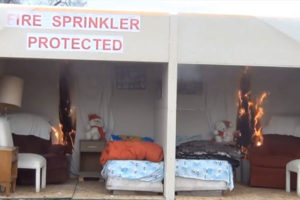Did you know that ASHI doesn’t require inspection of fire suppression systems as part of a standard residential home inspection?
Because more and more homes have fire suppression systems, and because fire suppression systems are important safety systems, your clients increasingly will ask you about fire suppression systems. Most homeowners likely are not familiar with residential fire suppression systems. You should take the opportunity to educate your clients and to dispel many widespread myths about how they work and the protection they offer.

Before we begin, check out this dramatic Sprinkler vs. Non-Sprinkler video, which shows what happens to two identical rooms, one with a sprinkler and another without a sprinkler.
What Exactly is a Fire Suppression System?
A fire suppression system is a fancy phrase for an interior sprinkler system. A fire suppression system is part of a home’s plumbing system and is designed to put out fires with water. Think of a fire suppression system as your own personal fire department inside your house except that your fire suppression system arrives instantly upon activation.
Do you know enough about fire suppression systems to be able to answer your clients’ questions?
Myth 1: Homes with smoke alarms don’t require fire suppression systems.
Wrong. Smoke alarms are tremendously helpful devices but they only alert occupants of a fire. Smoke alarms don’t put out fires. And, in some cases, people just don’t wake up when a smoke alarm rings. Plus, if there is an open fire burning, smoke alarms ultimately will fail, some within 40 seconds.
Myth 2: Fire suppression systems are activated by burning toast or candlelight.
False. Fire suppression systems are not activated by burning toast or candlelight or smoke or candelabra.
Myth 3: If one sprinkler is activated, they all go off.
Nope. You must have seen too many movies! Only the sprinkler that is required to suppress the fire is activated.
Myth 4: Water damage from the fire suppression system will be worse than the fire itself.
Wrong again. Interior sprinklers use about 10% of water for a room or space that otherwise would be drenched by the fire department to put out a fire. Damage from hoses will be much greater and much more widespread throughout a house.
Myth 5: New homes are safer from fires than older homes.
Not true. Old construction homes often are safer than new construction homes. It depends on the materials. Check out this Fire Materials video, which shows two fires, side by side, old construction materials on the left, new construction materials on the right.
Why Do We Inspect Fire Suppression Systems?
Because they are an important safety system in a home. Plus, other than the fact that fire suppression systems are increasingly common, all current US model codes require interior sprinklers in new one and two family homes. Although many states have opted out of the requirement, we believe that a visual inspection of an important safety system is an integral element of a home inspection.
To the best of our knowledge, US Inspect is the only inspection company which requires visual inspection of fire suppression systems as part of our standard home inspection.
Do you know your local requirements for inspection of fire suppression systems? If you or your clients have any questions about fire suppression or interior sprinkler systems, please don’t hesitate to ask one of our inspectors.
